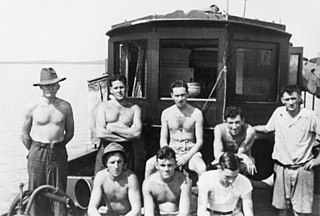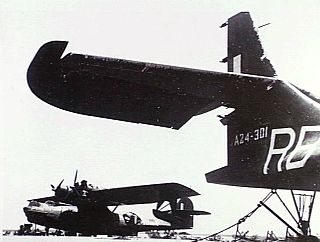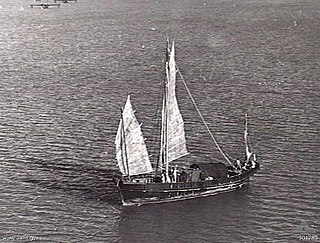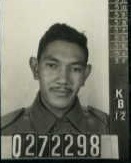Related Research Articles

Z Special Unit was a joint Allied special forces unit formed during the Second World War to operate behind Japanese lines in South East Asia. Predominantly Australian, Z Special Unit was a specialist reconnaissance and sabotage unit that included British, Dutch, New Zealand, Timorese and Indonesian members, predominantly operating on Borneo and the islands of the former Netherlands East Indies.

No. 18 Squadron was a joint Dutch and Australian bomber squadron of World War II. Formed in April 1942, the squadron was staffed by a mixture of Dutch and Australian personnel and placed under Royal Australian Air Force operational command. Initially it undertook anti-submarine patrols on the east coast of Australia, before moving to northern Australia and taking part in operations against the Japanese in the islands of the Netherlands East Indies (NEI). At the conclusion of hostilities, the squadron came under Dutch control and Australian personnel were transferred out. The squadron then undertook operations during the Indonesian National Revolution, before eventually being disbanded in July 1950 after being transferred to Indonesia.

No. 42 Squadron was a Royal Australian Air Force (RAAF) mine laying and maritime patrol squadron of World War II. It was formed in June 1944 and conducted patrol and mine-laying operations over the Netherlands East Indies (NEI) from August 1944 until the war ended a year later, as well as operations in the waters off southern China in early 1945. Following the Japanese surrender, the squadron performed transport and reconnaissance flights until it was disbanded in November 1945.
The Special Operations Australia (SOA), previously known as the Inter-Allied Services Department (ISD) and later given the cover name of the Services Reconnaissance Department (SRD), was an Australian military intelligence and special reconnaissance unit, during World War II.

The Snake-class junks were a class of six small vessels operated by the Royal Australian Navy (RAN) to support special forces operations in 1944 and 1945. The ships were lightly armed and were used to infiltrate special forces parties and their supplies into Japanese-held territory.

HMAS River Snake was a Snake-class junk built for the Royal Australian Navy during the Second World War. She was launched in 1945 and commissioned into the Royal Australian Navy on 19 February 1945. She was used by the Services Reconnaissance Department (SRD) and was paid off on 2 November 1945, before being handed over to the British Civil Administration in Borneo.
Operation Opossum was a World War II raid undertaken by Australia's Z Special Unit in 1945 on the island of Ternate near Borneo to rescue the Sultan of Ternate, Iskander Muhammad Jabit Syah.
Operation Adder was a military operation conducted by Australia's Services Reconnaissance Department in Timor during World War Two in August 1944. A party consisting of two Australian soldiers, Captain John Grimson and signaller Ernest Gregg, and three Portuguese Timorese, was dropped on Timor.
Operation Cobra was a military operation by Australia's Services Reconnaissance Department during World War Two in Timor in 1944. A team of five soldiers were inserted on to Japanese occupied Timor
Operation Lagarto was an Australian military operation in Timor during World War Two in 1943. It was run by the Services Reconnaissance Department. The Naval component of the mission was named Operation Mosquito. The operation was ambushed and captured. Japanese intelligence used information from the mission to lure other Australian commandos to Timor where they were captured and killed, notably Operation Cobra (Timor), Operation Sunlag and Operation Suncob.
Operation Sunable was a military operation by Australian forces in Timor during World War Two. It consisted of Lieutenant Williams, and Sergeants White, Shand and Curran.
Operation Lizard was the name given to a series of operations undertaken in Portuguese Timor by Australian troops in World War Two using Hoehn military folboats to get from the vessel to the island and return.
Operation Tiger was the name given to a series of operations in World War Two by the Netherlands East Indies Forces Intelligence Service on the island of Java. Almost all ended in disaster for the Allies.
Operation Walnut was a military operation conducted by the Allies, notably the Netherlands East Indies Forces Intelligence Service, on the Aroe Islands during World War Two. It took place in three phases:
On 5 January 1945, a party of five Indonesians under the codename of Operation Apricot left Darwin to ascertain the fate of Operation Lion.
Operation Sunfish was a military operation by Allied troops in April 1945.

Operation Binatang was an Australian covert operation conducted by the Services Reconnaissance Department (SRD) during World War Two. An agent of Z Special Unit was to be landed on the north coast of Java to recruit more men who would give active assistance to the allied cause. The operation was conceived in January 1944 but owing to the shortage of available submarines and the priority of Operation Hornbill it was delayed. When Hornbill was aborted arrangements were made for the mission to commence in February 1945.
Operation Flounder was an operation carried out in World War Two by the NEI. Eight men, all NEI, were put on shore at Ceram Island. Contact was lost. It later emerged that at least two had been executed.
Operation Starfish was an operation by Australian special forces in World War Two on the island of Lombok.
Operation Groper was an operation by Australian special forces immediately after World War Two to discover the fate of missing Australian soldiers on Timor.